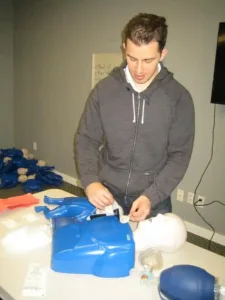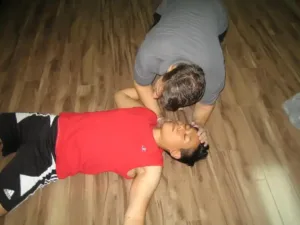Hamilton First Aid is the leader in first aid training in Hamilton, Ontario. They are affiliated with St Mark James and offer nationally-accredited certificates, valid for 3 years. All training courses offered by Hamilton First Aid are certification courses, with the lowest rates in Hamilton. Hamilton First Aid has refresher / re-certification courses, stand-alone classes, and private classes. Prospective trainees can easily enrol via the on-line application form below, e-mail, telephone call, or walk-ins at the training center.
Additional information regarding classes, schedules, and enrollment can be found on the Hamilton First Aid website.
Why enrol at Hamilton First Aid?
Lowest Rates for workplace approved Classes in Hamilton
Hamilton First Aid offers a wide range of training and refresher courses at the most affordable costs. All rates are inclusive of taxes, certificates, and workplace approved registration fees. Trainees don’t have to worry about additional expenses during their training because equipment and manuals used are included in the initial enrolment fee. Hamilton First Aid also offers full refund, as long as the trainee gives a 72-hour notice. You can’t find more competitive rates than those offered by Hamilton First Aid.
Largest Selection of St Mark James First Aid and CPR Courses
Because of the increase in popularity of first aid classes, Hamilton First Aid offers a wide range of training courses to choose from, all held at various schedules throughout the week, including weekends. CPR training courses are divided into 3 levels: “A”, “C”, and “HCP”. Each level inclusive of basic first aid and AED training. The following list is just some of the classes offered at Hamilton First Aid:
- Standard 1st aid
- Standard Childcare 1st aid and cardiopulmonary resuscitation
- Emergency first aid and cardiopulmonary resuscitation (CPR)
-
First aid training in Hamilton Emergency Childcare 1st aid
- Basic Marine first aid and cardiopulmonary resuscitation (CPR)
- Babysitting 1st aid and cardiopulmonary resuscitation (CPR)
- Cardiopulmonary resuscitation level HCP
- Cardiopulmonary resuscitation (CPR) level -A and AED
- Cardiopulmonary resuscitation C and AED
CPR and AED training have gone hand-in-hand since the recent updated in Basic Life Support (BLS). BLS is a set of guidelines created by the American Heart Association and workplace approved that focuses on the emergency response system after recognition of cardiac arrest. Some of the previous steps have been removed, with two main steps being emphasized (seen below.)

“Look, Listen, Feel” has been removed from the guidelines, emphasizing the immediate start of chest compressions. Compressions that are begun early have been shown to improve the chances of survival of a victim of cardiac arrest. AEDs are machines that detech hearth rhythm and give an electrical shock in an attempt to restart the heart. More updates can be seen in the training video below, which are included in the CPR training courses.
Stand-alone classes that focus on one topic such as first aid or CPR and AED only are available for trainees who do not want to undergo an entire training courses. Private classes are usually offered to companies or big groups who wish for a separate class and schedule for their training. Companies usually train employees for skill development and team building.
St Mark James Accreditation
Trainees who are able to successfully complete a training course will be awarded a workplace approved certificate for first aid, CPR, and AED, valid for 3 years throughout Canada. Refresher courses for renewal of expiring or near-expiry certificates are offered at least twice a week, with notably lighter course load than regular courses.
Enrol with Hamilton First Aid to ensure you obtain the highest quality training at the most affordable rates!
Still not convinced? Get a free lesson with Hamilton First Aid below!
Chest Injuries – Pneumothorax, Flail Chest and Rib Fractures
When enrolled in first aid training with Hamilton First Aid, you will learn about a variety of injuries and how to recognize and manage them. One topic covered in workplace approved courses is chest injuries and the breathing emergencies associated with them.
- Pneumothorax – This injury occurs as a result of air getting into the the space between the lung and pleural membrane, that can cause the lung to collapse. This can happen with stab wounds or penetrating injuries to the chest.
- Flail Chest – A flail chest occurs when several ribs in the same area are broken in more than one place. This causes the injured wall of the chest to flail (instead of expanding during inhalation, the chest wall sinks) hence the term “flail chest”. This movement is called paradoxical breathing.
- Rib Fracture – A rib fracture occurs when one or more of the ribs have a fracture. It is very painful and can cause difficulty in lung expansion, which can compromise breathing.

